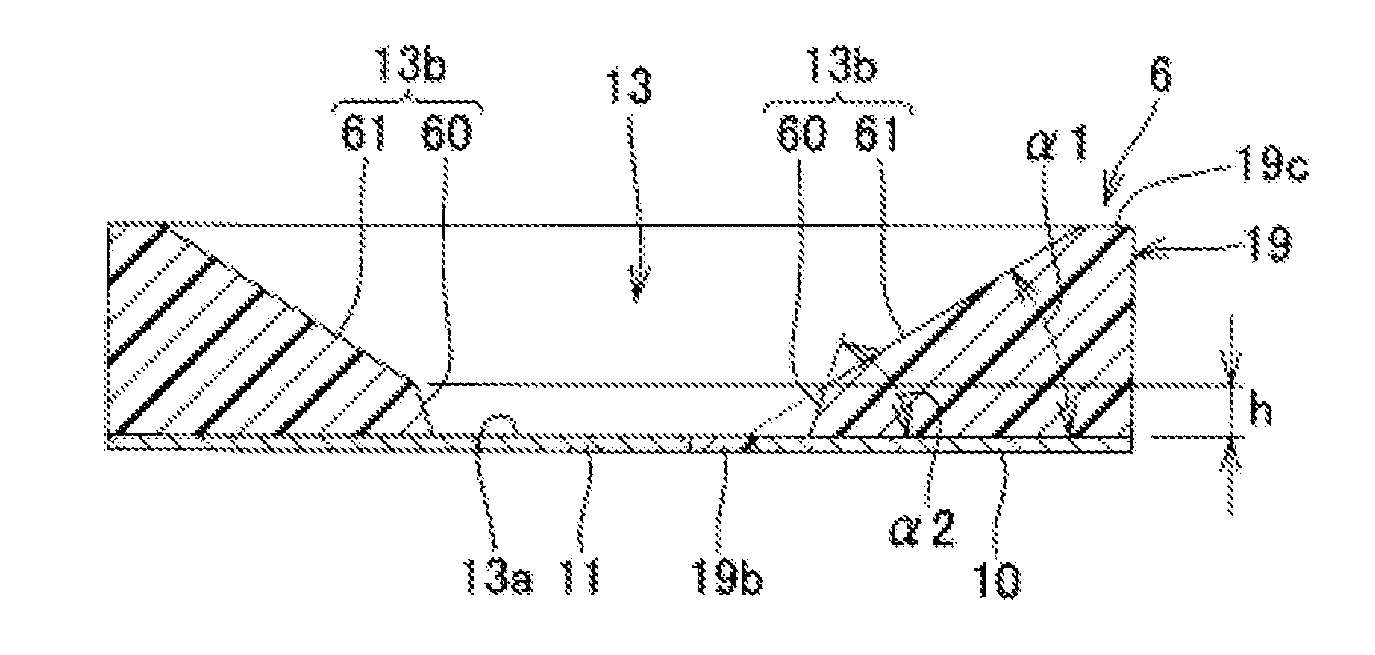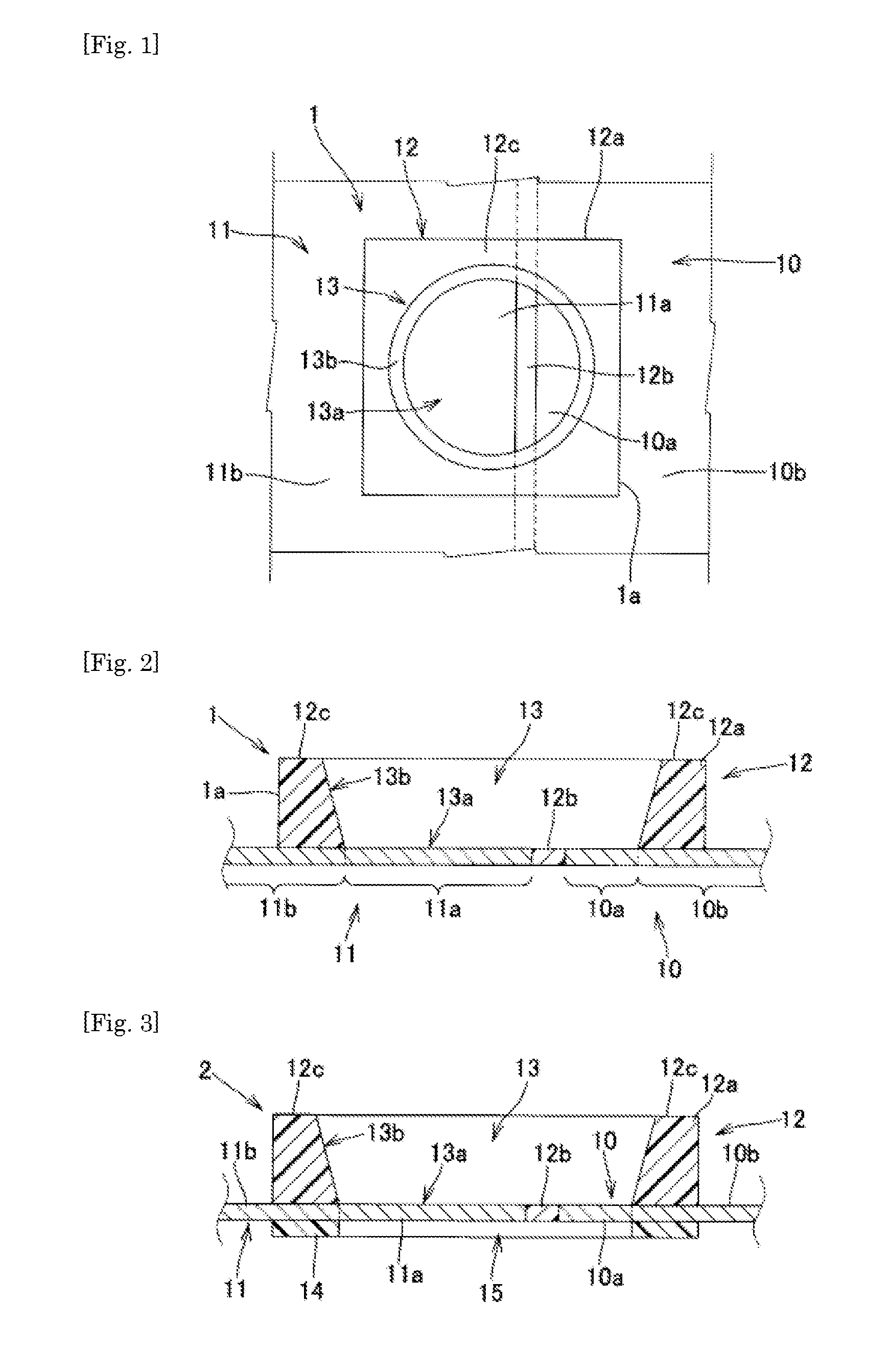Molded resin body for surface-mounted light-emitting device, manufacturing method thereof, and surface-mounted light-emitting device
a technology of molded resin and light-emitting device, which is applied in the direction of lighting and heating apparatus, transportation and packaging, coatings, etc., can solve the problems of reducing optical reflectance, complex formation operation of the molded resin body, and reducing optical reflectance, so as to achieve high optical reflectance, reduce deformation and breakage of the molded resin body, and be suitable for mass production
- Summary
- Abstract
- Description
- Claims
- Application Information
AI Technical Summary
Benefits of technology
Problems solved by technology
Method used
Image
Examples
synthesis example 1
[0405]A stirrer, a dropping funnel, and a condenser tube were set in a four-necked 5-L flask. To this flask were added 1,800 g of toluene and 1,440 g of 1,3,5,7-tetramethylcyclotetrasiloxane, and then the flask was heated and stirred in a 120° C. oil bath. A mixed liquid of 200 g of triallyl isocyanurate, 200 g of toluene, and 1.44 mL of a xylene solution of platinum-vinylsiloxane complex (platinum content: 3% by weight) was added dropwise over 50 minutes. The obtained solution was heated and stirred as it was for 6 hours, and then unreacted 1,3,5,7-tetramethylcyclotetrasiloxane and toluene were distilled off under reduced pressure. It was found by the 1H-NMR measurement that the obtained compound had the structure obtained by a reaction of a part of the SiH groups of 1,3,5,7-tetramethylcyclotetrasiloxane with trially isocyanurate shown in the following [Chemical Formula 33].
synthesis example 2
[0406]A 2 L autoclave was charged with 720 g of toluene and 240 g of 1,3,5,7-tetramethylcyclotetrasiloxane. Then, the gas phase was replaced by nitrogen, and then heated and stirred at a jacket temperature of 50° C. A mixed liquid of 171 g of allyl glycidyl ether, 171 g of toluene, and 0.049 g of a xylene solution of platinum-vinylsiloxane complex (platinum content: 3% by weight) was added dropwise over 90 minutes. After the completion of the dropwise addition, the jacket temperature was raised to 60° C., and then a reaction was allowed to proceed for 40 minutes. It was confirmed that the reaction rate of allyl groups was 95% or more by the 1H-NMR.
[0407]A mixed liquid of 17 g of triallyl isocyanurate and 17 g of toluene was added dropwise to the obtained reaction mixture. Then, the jacket temperature was raised to 105° C., and then a mixed liquid of 66 g of triallyl isocyanurate, 66 g of toluene, and 0.033 g of a xylene solution of platinum-vinylsiloxane complex (platinum content: 3...
formulation example 1
[0409]Components were mixed in the proportions shown in Table 1 to prepare thermosetting resin compositions A to D.
TABLE 1ComponentsThermosetting resin compositionTypeCompound nameABCD(A)Triallylisocyanurate40.2 g 2.9 g19.4 g58.3 gDiallyl monoglycidyl isocyanurate28.1 g13.9 g41.71 g (B)Product of Synthesis Example 159.8 g29.3 g88.21 g Product of Synthesis Example 260.0 g37.4 g112.48 g (C)Xylene solution of platinum-0.05 g0.018 g 0.029 g 0.09 gvinylsiloxane complexCuring1-ethynyl-1-cyclohexanol 0.3 g 0.1 g 0.2 g0.49 gretardant
PUM
| Property | Measurement | Unit |
|---|---|---|
| roughness | aaaaa | aaaaa |
| roughness | aaaaa | aaaaa |
| size length | aaaaa | aaaaa |
Abstract
Description
Claims
Application Information
 Login to View More
Login to View More - R&D
- Intellectual Property
- Life Sciences
- Materials
- Tech Scout
- Unparalleled Data Quality
- Higher Quality Content
- 60% Fewer Hallucinations
Browse by: Latest US Patents, China's latest patents, Technical Efficacy Thesaurus, Application Domain, Technology Topic, Popular Technical Reports.
© 2025 PatSnap. All rights reserved.Legal|Privacy policy|Modern Slavery Act Transparency Statement|Sitemap|About US| Contact US: help@patsnap.com



